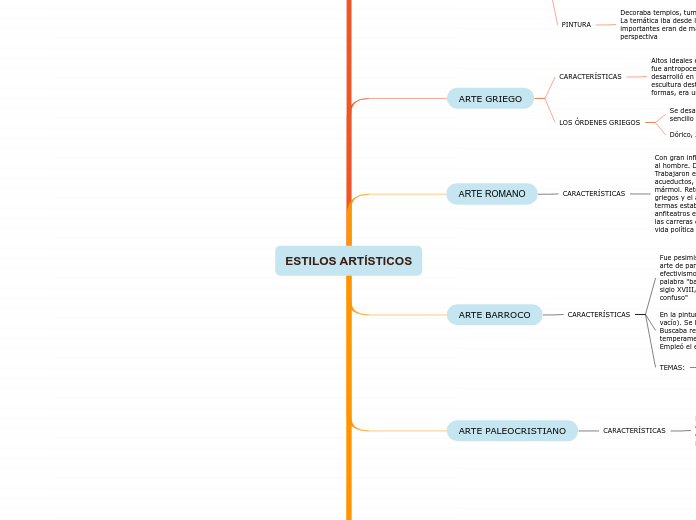によって Viviana López 4年前.
1161
ESTILOS ARTÍSTICOS

によって Viviana López 4年前.
1161

もっと見る

To name your story, you have to think about the overall message and what you want your audience to understand from the story. Also, make it relevant and easy to remember.
El arte fue un reflejo de la ostentación y solemnidad que rodeó a los emperadores y se convirtió en símbolo del poder político y religioso. La arquitectura en el periodo Justiniano se utilizó para impresionar a los pueblos. La ARQUITECTURA ERA MUY COSTOSA. Antes de Justiniano la basílica seguía la estructura paleocristiana, luego surge la iglesia de planta central, abovedadas, nave para el coro y el deambulatorio para los fieles
SEGUNDA EDAD DE ORO
Los turcos toman Constantinopla
PRIMERA EDAD DE ORO BIZANTINA
Los cruzados destruyen Constantinopla
PROTOBIZANTINO
Surge la querella inconoclasta [iconoclastas vs iconódulos (devotos de las imágenes) (527-726) fue una crisis artística en el arte figurativo
SEGUNDA ETAPA
Nace la arquitectura cristiana: basílicas, baptisterios y mausoleos
Nace fuera de la ley para mantener y transmitir la fe. Y acentúa la espiritualidad e igualdad de todos ante Dios. Se manifiesta en las construcciones patricias (centros de reunión de los primeros cristianos)
ETAPA PRIMITIVA
Fue clandestina y de escaso desarrollo. Duró hasta el edicto de Milán -fue cuando se reconoció la legalidad de la religión cristiana-
Historia, mitología, religión, fugacidad del tiempo, desencanto, costumbres, vida cotidiana
La mitología fue muy importante (neoático) y el período helenístico la pintura fue rural, marina y de paisajes.
The ending of a story is essential. We all know that if the ending is weak, what happened before loses its importance. So make it unpredictable, but fair. A resolved ending answers all the questions and ties up any loose threads from the plot.
This is the closure section of the story.
See examples of possible outcomes below:
Try answering these questions to come up with a closure:
- Have all the problems been solved?
- Is there a clear picture of what happens with each character in the story?
- Has the challenge transformed your main character?
- How do the characters feel in the end?
This is the moment when the main character surpasses the last obstacle and finally faces their greatest challenge.
The climax usually follows one of these patterns:
Type in your answer.
The middle of the story is where you add layers of complications that will lead to the end. Reveal more about the character's journey. Did their personality go through changes? How did they overcome the challenges? And as you build up the story’s central conflict, make it more personal to that character. Also, from the middle act, you have to lead into the final act.
There wouldn't be any tension and excitement in your story if there weren't any obstacles in your character's way.
A story is nothing more than a character overcoming a series of difficulties to reach the desired goal. Obstacles usually create suspense and conflict. In overcoming obstacles, there is growth: weak becomes strong; hatred turns into love; sadness into happiness; wrong into right; lies into truth; or evil becomes good.
See a few examples below:
Your character(s) need(s) motivation in order to solve the challenge(s).
Secondary characters might also have motives that lead them to cross paths with the main character or which might trigger them to help the main character.
Figurillas que representaban la vida cotidiana
Figuras rígidas y estáticas
Why does your character need to confront this challenge? What does he/she expect to accomplish by solving it?
See a few examples:
Colosal. Utilizaron la columna, dinteles, predominan las líneas rectas sobre las curvas. Destacan las tumbas y los templos
Each story has a main character and that character usually needs to solve a problem or challenge. The character's challenge is the one that creates tension throughout the story.
In most stories, there are 3 challenges. The number 3 is a mystical number symbolizing completeness. Try to come up with interesting challenges with which your character needs to struggle.
See a few examples below:
In the beginning of the story (or the exposition), you will need to introduce the setting and characters. You might also want to introduce the main conflict. This part of the story is important because it gives the reader necessary background information and maybe even a first insight into a character’s personality.
The setting (time & place) of a story can change throughout the plot.
Sensory details include sight, sound, touch, smell, and taste. These details are important because they create depth in your setting.
See a few examples below:
Formado por varios dólmenes y menhires
The time of the story can also change. It can describe the event of a single day or can include an entire year's plot. Anyway, don't forget to mention it.
Sobre los dolmen descansan otras grandes piedras
Un dolmen se forma por varios Menhires
Your story can take place wherever your imagination will take you to.
For example: in an elevator, in an enchanted forest, etc. Don't forget to give details of the environment each time the setting changes, otherwise, the story can be confusing. Also, mention the seasons as each of them has unique weather and events.
Location
Gran piedra clavada
Characters are essential to a good story. Usually, the protagonist(s) is/are the most affected by the plot. Introduce a character by focusing on their actions, interests, and occupation, as the physical appearance doesn't make a difference in most cases.
Type in the name of your character.
Se destacan las pinturas de Las cuevas de Altamira y Lascaux, Francia.
Add other qualities/attributes of the character.
estatuas antropomórficas y zoomórficas talladas en arcilla y piedra
What is your character's main goal?
También se le conoce como arte mueble
Which traits best describe the character's personality? Choose more if necessary:
son los primeros vestigios de que se tiene registro
Choose the type of your chacter: